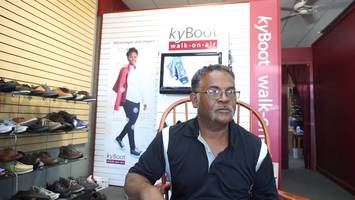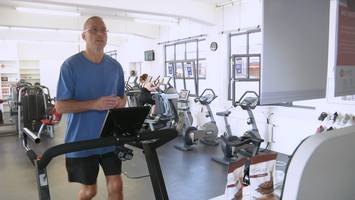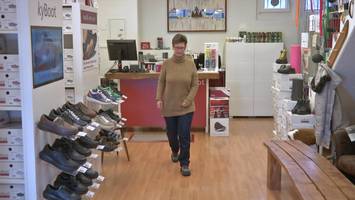Stroke
Stroke is among the most common illnesses and the third most frequent cause of death in Germany. Furthermore, stroke is the most common cause of moderate and severe disability.
Thanks to light everyday exercise, kybun keeps your body fit and strong, which helps with prevention. After a stroke, kybun can provide significant rehabilitation support by restoring the body’s balance through gentle training.
Definition
A stroke is the sudden onset of brain disease that often leads to a lasting failure of central nervous system functions; it is caused by critical disruptions of the blood supply in the brain.
Causes
- Arterial embolism due to blood clots
- Venous thrombosis, impairing the return flow of blood
- Blood vessel constriction due to vascular spasms
- Vascular ruptures, spontaneously or e.g. due to high blood pressure
- Spontaneous bleeding in case of blood clotting disturbances
- Subarachnoid haemorrhage, subdural or epidural haematoma
Long-term consequences
The consequences of stroke are often similar, yet individual in each case. In the first few days after a stroke, it is still not possible to assess what disabilities the affected individual will have over the long term. The consequences that need to be mastered are more clearly discernible after two to three months.
- In most cases, a certain degree of paralysis of the face, arm and/or leg on one side of the body will remain. This is known as hemiplegia (hemiparesis). Such a paralysis is often accompanied by paraesthesia in the affected area.
- If the left cerebral hemisphere is damaged, language disturbances (aphasia) of various severity are often seen while only amnesic aphasia occurs in other cases. The ability to understand language, writing, arithmetic and the ability to read may be impaired.
- A stroke can lead to paralysis of the speech musculature which affects pronunciation and vocalisation so the person has speech disorders. Dysphagia (difficulty swallowing) as a result of paralysis means there is a constant risk of choking.
- Incontinence develops when the region of the brain that controls the urinary bladder and rectum is damaged.
- A stroke also frequently causes a number of impairments in mental (cognitive) performance. Impairments of concentration, memory, planning and acting as well as visual-spatial performance are the most common.
- Emotional (mental) problems can develop in response to the sudden, dramatic change in the life situation. People handle the illness in very different ways.
In brief: A stroke can lead to a wide variety and severity of symptoms. All aspects of familiar everyday life are suddenly altered – for the affected individual and the people around them.
Conventional therapy
For example, gait patterns are practiced with a physiotherapist to restore the ability to walk. Occupational therapists work with patients, focusing on (partly) restoring sensorimotor abilities.
The importance of focused speech therapy commencing in the early phase and extending over a long period of time is often underestimated.
The kybun principle of operation – being proactive
Prevention
- The soft, elastic kybun material is very comfortable and motivating for getting more day-to-day exercise. Moderate exercise constitutes very healthy and efficient cardiovascular training.
- Regular kybun training keeps your cardiovascular system in shape and you can lose extra pounds at the same time (see micro-interval training).
- On the soft, elastic material of the kybun mat/kybun shoe, you automatically stand more upright, which helps relieve muscle tension (superficial musculature) in the neck and back. The core postural muscles are trained as well and back pain is alleviated.
- The kybun mat/kybun shoe also promotes blood circulation in the entire body throughout the day. This is important for maintaining the health of the organs, musculoskeletal system and blood vessels. You will clearly feel the effects of improved blood circulation to the head after lunch, when you stand on the kybun mat at the office feeling much fitter and free of the usual fatigue.
- The soft, elastic material of the kybun mat/kybun shoe dampens the impact of hard surfaces. This protects your joints, reduces pain and allows you to walk upright for longer.
- Those who exercise regularly throughout the day have fewer unhealthy eating attacks and feel much more balanced in the evening. With kybun this becomes possible without expending additional time.
Micro-interval training
We recommend ‘micro-interval walking’ as a highly efficient training method. The intervals between walking slowly and ‘lightly floating’ are between 15 and 30 seconds.
This change in speed is not just fun but also highly efficient:
- In the ‘lightly floating’ phase, the cardiovascular system is activated and the musculature is loosened.
- In the ‘walking slowly’ phase, the cardiovascular system is regenerated and coordination (fine musculature) is trained. This works better the slower you walk, because you then stand on one foot (unstable, soft, elastic kybun shoe) for longer.
We are convinced that there is no better form of exercise for the health of the entire body than this ‘micro-interval walking’. It is important to only float lightly for about 15 seconds and walk slowly until the pulse has recovered sufficiently again. This also results in optimum fat burning.
Rehabilitation after a stroke
- The soft, elastic material of the kybun mat enables gentle training of balance, body perception and muscular strength even in the early rehabilitation phase.
- The kybun mat is available in various thicknesses so the difficulty of kybun training can be individually adapted (the thicker the kybun mat, the more challenging the training). To find the right kybun mat thickness, we advise you to try out the various possibilities at a kybun dealer.
- Training on the kybun mat and later also in the kybun shoe automatically exercises the weaker half of the body as well (the body is forced to do this on the soft, elastic material since it would otherwise lose its balance). Asymmetries are corrected and limping mechanisms are reduced.
Initial reactions
Specific initial reactions after a stroke:
Depending on the severity of physical weakness after the stroke, the kybun shoe may be too unstable and shaky at first. In this case, we advise testing the various thicknesses of the kybun mat. This allows you to gently adapt rehabilitation training to your needs.
Click here for the general initial reactions experienced by kybun mat and kybun shoe beginners: Initial reactions
kybun exercises
Application tips
Prevention (micro-interval training)
- Reduce your walking speed a little in the beginning and only walk at a pace that allows you to talk to your partner.
If you are under the care of a doctor, we advise you to wear a pulse meter so you can keep to a pulse set for you personally by your doctor. - You should feel well at all times during kybun training! Feeling unwell is a sign that you are overtaxing your body and/or heart. Once again, adjust the speed of both intervals so that you feel good during training and avoid overstraining your body.
- Check your body posture regularly: You should walk upright and keep the arms, shoulders and feet loose.
When you push the limits of your fitness, you tend to cramp up. This restricts blood circulation and the organs no longer receive an adequate supply of oxygen, which would force you to stop training after a short time.
Rehabilitation
- Due to the great variation of the clinical picture, it is not possible to make general statements regarding the effects of and initial reactions to kybun. While this page contains a lot of good information and tips, your personal experiences may be different. We would be very interested to hear from you in such cases and would gladly provide you with personal advice.
- Especially for rehabilitation after a stroke, kybun training has to be individually adapted. Carefully develop the kybun training depending on the extent of subsequent problems. Initial reactions should be avoided in the beginning, so less is often more. Choose the kybun mat thickness you think is most suitable and only train on the kybun mat/in the kybun shoe as long as you do not experience increased pain, are able to stand upright (without lateral/medial rolling of the ankle joint on the material) and do not get severely fatigued.
- Due to the variety of symptoms and subsequent problems following a stroke, we recommend always testing the kybun mat/kybun shoe on site. A kybun specialist can provide you with personal advice and discuss your requirements.
- Try to integrate frequent kybun training into your daily routine. It is better to train more often for shorter periods.
- The kybun mat is ideal for practicing the balance exercises learned in physiotherapy at home.
- Once you are accustomed to the kybun mat and feel physically confident and stable, performing everyday activities such as cooking, ironing or watching television while standing on the kybun mat is ideal.
- kybun micro-interval training is also very well suited for rehabilitation, particularly at a later stage. The right time to start is highly individual and depends on your physical condition.
Opinions/customer testimonials
I feel it throughout my entire body. I have been able to significantly reduce the spasticity in my shoulder and in my arm. It’s still a little bit stiff, of course. The spasticity caused my arm to be stuck in a rigid position on my chest. That caused a lot of pain and tension in my body, but I don’t have that anymore. I no longer have to put up with it. I feel a lot more relaxed now; my back doesn’t tense up, and I can even raise my arm. The reason all this has happened is because my muscles are relaxed, and I believe that this is down to wearing the kybun shoe. This shoe has made all this possible.
It took me at least ten years to regain some sense of normality in my life. I have been back on my feet for the last five years, and now I’d like to be able to walk without feeling any pain. That’s why I ended up trying out the kybun shoe. I will wear this shoe for the rest of my life. Wearing this shoe is a true pleasure.
My mother and my brother, for example, have told me that I have been much more agile when I’m out and about. Maybe I haven’t noticed it myself, but other people have been telling me that I seem a lot more agile when I’m on the go. I’m much fitter throughout the day, because it doesn’t hurt me to wear it and it doesn’t rob me of my energy.
It was an experiment and we had no scientific proof that it would work. We were surprised to discover that it could improve neurological movement disorders, including MS and Parkinson’s disease. Of course, we also have patients with paralysis caused by a stroke, for example. We let them walk on the soft, springy kybun mat. We saw a clinical improvement in the situation. For example, this means that all of a sudden, patients with Parkinson’s disease require less medication or even none at all. They also no longer experience tremors. We’ve also noticed an improvement in MS patients, but we have definitely seen the greatest improvement in patients with Parkinson’s disease. However, mobility has also improved for patients with paralysis. It is actually a mystery to us how these improvements came about. We just don’t know. We can only assume that the stimulation caused by spatial awareness and in the lower extremities stimulates brain tissue. Certain interactions that were disconnected are suddenly open again. This is typical in Parkinson’s disease. We are continuing our research in this area in order to be able to confirm this with other patients with Parkinson’s disease. We were very surprised that it has an effect and of course, we’re delighted that it’s possible to help these patients.












